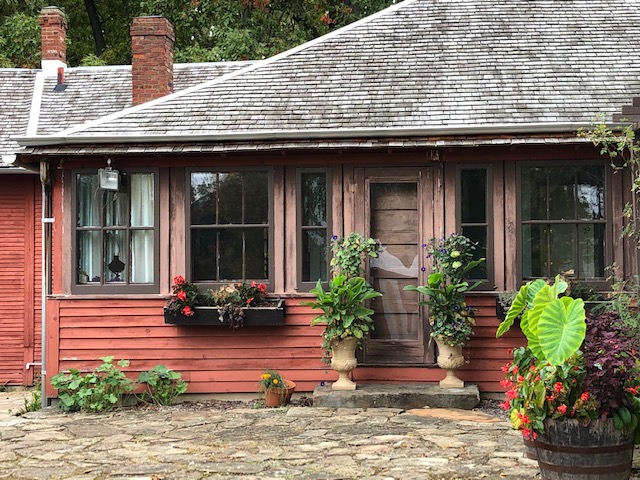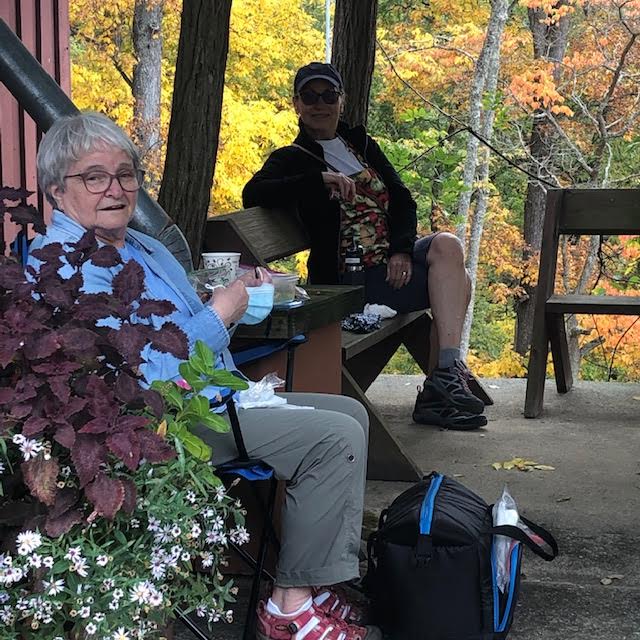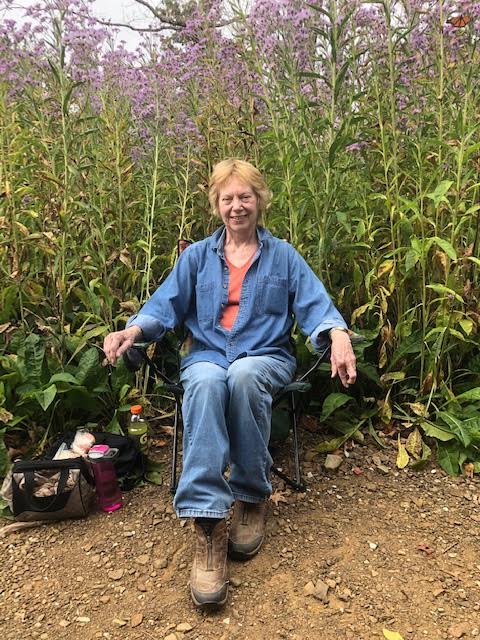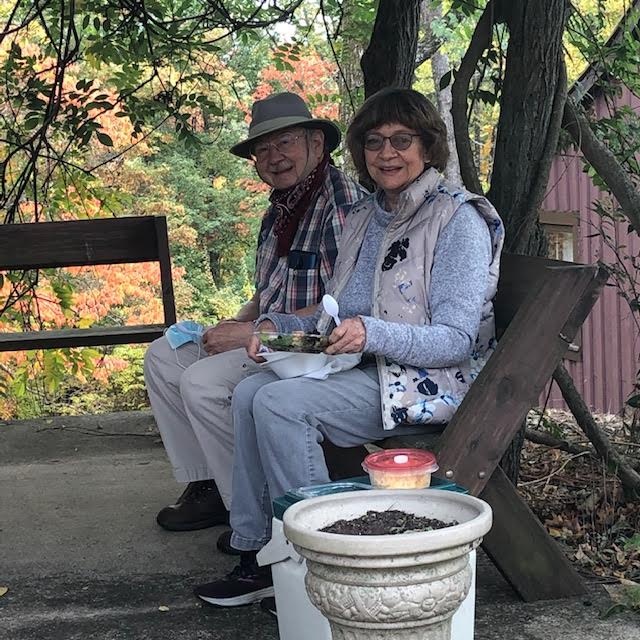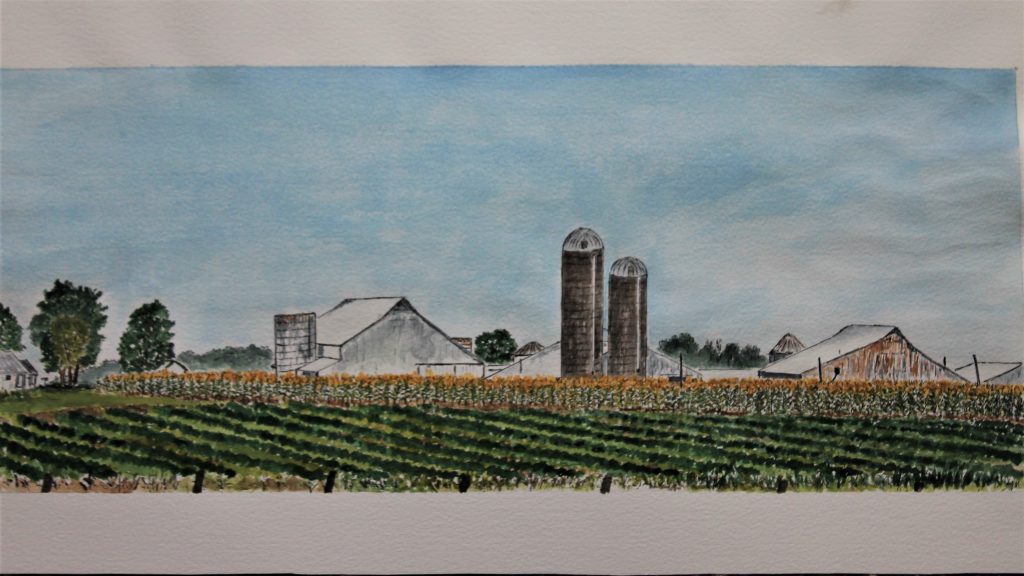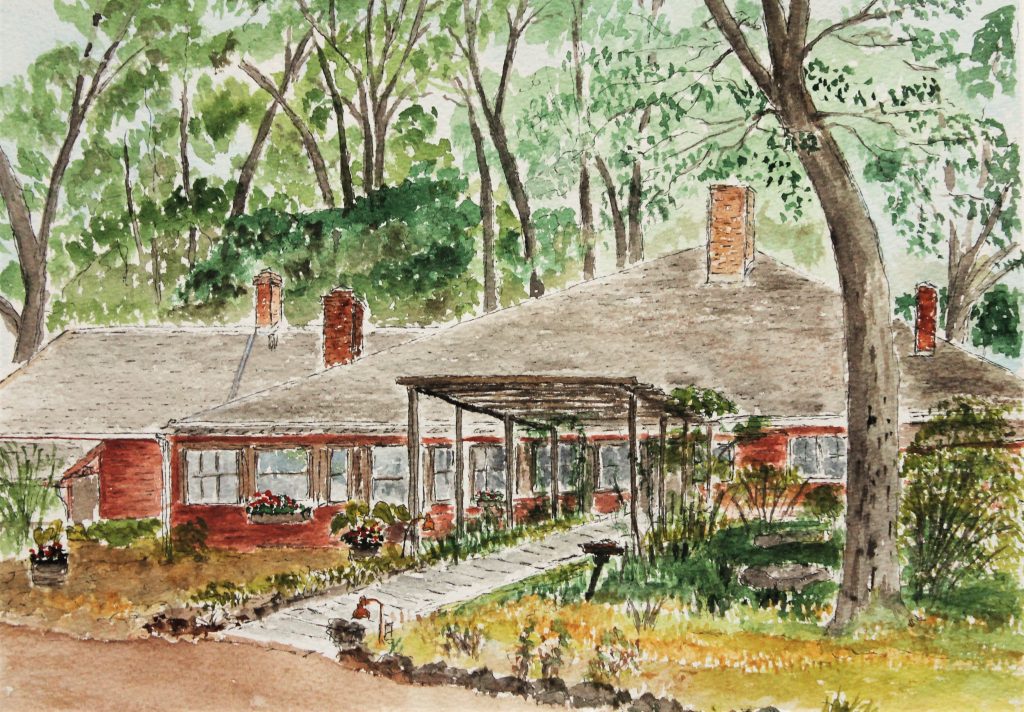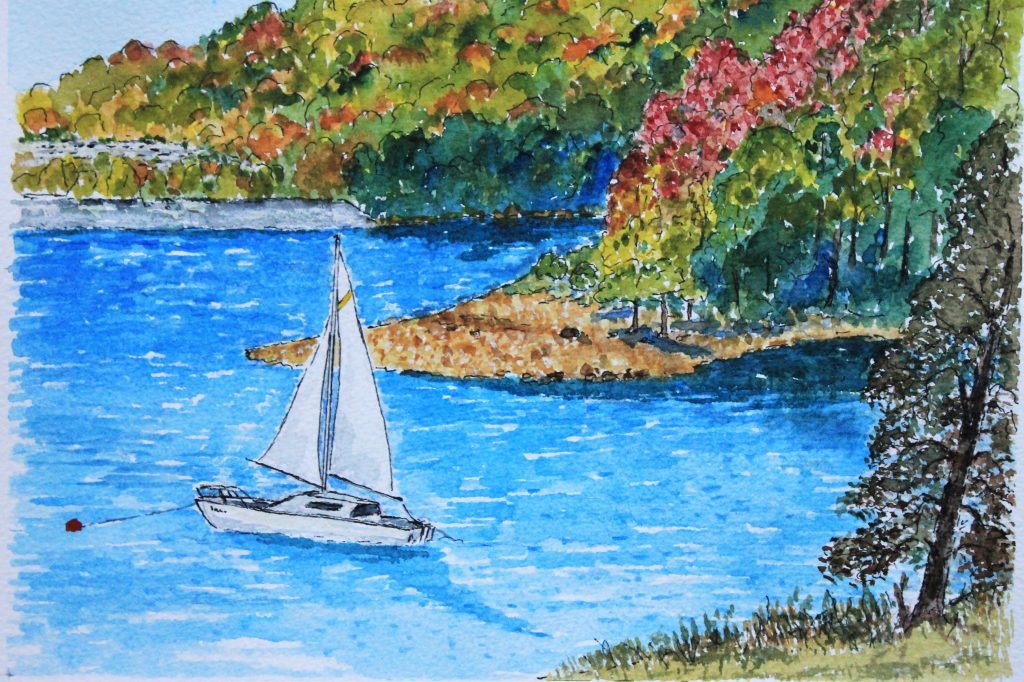Nov. 9
BWS program to feature
“Indiana Greens Throughout the Year”
Following the November business meeting, Kathy Truelove Barton will demonstrate mixing greens for the many changes of foliage color between April and the end of October. She will use four of her paintings created at different times of the year — early spring, early summer, late summer and early fall — as a guide for the colors. Kathy will use tube paints from Winsor Newton Professional and Daniel Smith Professional lines. Handouts including the brands and paint numbers where available will be emailed the first Friday of November. However, members can create similar colors from the paints they have on hand.
Suggested supplies: Number 4 and 6 brushes; watercolor palette or an all-white dinner plate; a light, medium and dark shade of yellow, blue, and green.
The business meeting starts at 6 p.m. via Zoom. A link to the meeting will be emailed to BWS members the day of the meeting.
Announcing “We Paint … Carnival!”
MONTH of CHOCOLATE, February 2021
BWS will participate, for the sixth year, in supporting LIFEDesigns in the annual Month of Chocolate this coming February. The event will be different than before, but members can anticipate a guided video tour, lots of publicity, and a Best of Show award.
Look for the prospectus to arrive soon, once the dates are confirmed with the Vault at Gallery Mortgage. If you want to get an early start, remember all mediums are accepted in a 2D format, framed appropriately.
Thanks to our president, Joanna Samorow-Merzer, for suggesting this year’s theme of “Carnival.” This may inspire you a bit!

/?kärn?v?l/
A period of public revelry at a regular time each year, typically during the week before Lent in Roman Catholic countries, involving processions, music, dancing, and the use of masquerade.
“the culmination of the week-long carnival”
FMCCS auction to benefit
the BWS scholarship
The BWS Art Scholarship is managed through the Foundation for Monroe County Community Schools (FMCCS). We couldn’t hold our annual table sale this fall to renew our scholarship fund, but FMCCS has offered us the opportunity to enter items in their annual online auction. Seventy percent of any sale will go to the Scholarship fund; 30 percent will be retained to cover costs.
BWS members are invited to donate something art related – a painting, a set of notecards, a print. So far, three paintings have been donated – and thanks to those artists! (One donation includes a Longaberger basket filled with beginning art supplies and two hours of watercolor instruction!)
The deadline for donations is Nov. 18. To contribute an item, please contact Jeanne Dutton at Scholarship@BloomingtonWatercolor.org.
The online auction opens Nov. 30 at biddingforgood.com/auction/auctionhome.action?vhost=fmccs.
Watch your email for updates!
Membership Show
People’s Choice Awards announced
Stephen Edwards’s painting, Thawing Along Owl Creek, was the first place winner in the People’s Choice Awards for the 2020 BWS Membership Show.
Ballots were counted from the in-person viewing at The Vault and email voting from the online gallery hosted by SmugMug.com and BWS, and the results were announced by Show Chair Kathy Barton and 1st Vi ce President Patty Uffman.
Runner-up was Green Pears, Ready to Pick by MarySue Veerkamp-Schwab. Honorable Mentions were awarded to At Ghost Ranch, NM by Candace Bailey and Rainwashed Vienna by Carol Rhodes.
These paintings along with the entire show is still available for viewing at https://bloomingtonwatercolor.smugmug.com.

Kudos
2020 Membership Show
Let’s express our appreciation to Kathy Barton and Patty Uffman who created the actual exhibit and to Carol Rhodes and Charlotte Griffin who created the virtual reception and the virtual gallery, and to Jeanne Dutton who prepared the labels to accompany the paintings at the gallery, also to Kathy’s husband Craig who created the flyer for the exhibit, and to Kriste Lindberg for the publicity. Please let’s make sure that we show our appreciation as well to John LaBella, the owner of The Vault Gallery Mortgage Company, who is so kind to us and welcomed again this year another BWS art show in his space. And many thanks to our BWS artists who brought their paintings to the exhibition. With all this collective work we made it happen! It was a beautiful art show.
Thank you all,
Joanna Samorow-Merzer
BWS President
2020-2021
My favorite technique
Using wet in wet to create
hard edges for rim lighting
by Claude Cookman
When I showed a painting of a geranium at BWS’s September Show-and-Tell, one of our members asked how I got such hard edges on the petals. I’m happy to share that technique, but I’d like to expand my response slightly. I was using those hard edges to produce rim lighting, the effect of a bright light catching the edge of an object and outlining it in sharp detail.
This demonstration pulls together two big art ideas. First, many artists insist they paint light, not objects. Second, edges are a major tool in constructing pictures. Artists talk about hard edges, soft edges and lost edges. To make something recede, typically in the background, they use soft or lost edges. To emphasize an object — the focal point, for example — artists often give it hard edges.
This technique works because of a unique property of the watercolor medium: If you wet good paper, then add watercolor to this area, the colors will not extend beyond the wet boundary.
Follow these steps:
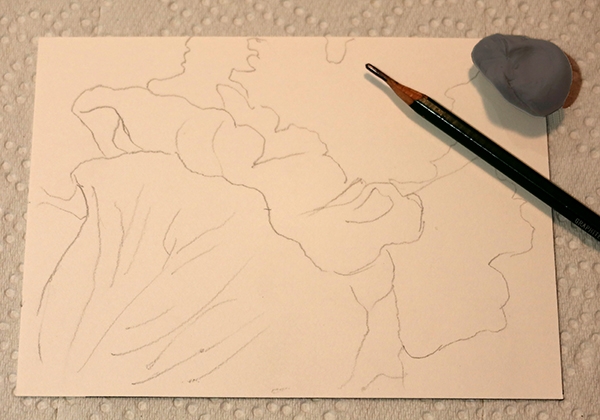
1. Theory. Lightly draw your motif; then use a kneaded eraser to remove as much graphite as possible, leaving barely visible lines.
Practice. In this demonstration, the motif comprises two flower petals and the leaves around them. I’m creating rim lighting between the two petals and between them and the leaves. I’m drawing just the petals and trusting that I can paint the background edges without needing a pencil line. In this case, I left the lines much darker than I normally would so you can see them.
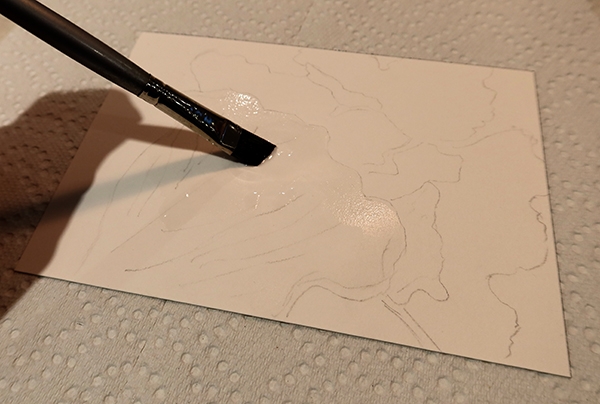
2. Theory. Wet an area thoroughly with clear water. Paint right to the edge of the line, but not over it.
Practice. I used a half-inch chisel brush. And painted two coats of water to make the area very wet. I let the paper rest for two or three minutes to absorb any puddles.
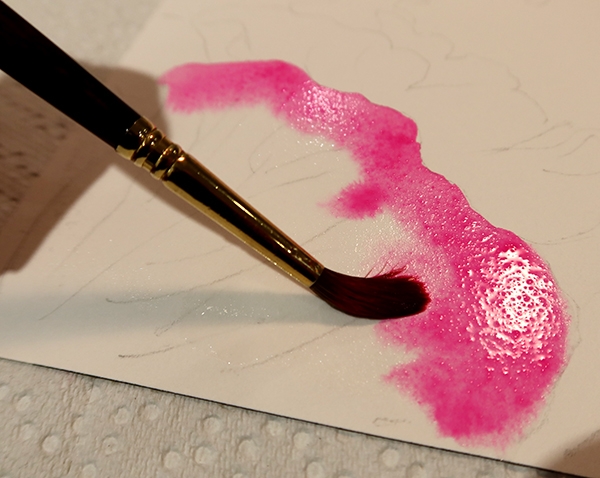
3. Theory. While it’s resting, mix your colors. Experiment with consistency to find the results you like best. For starters, make it somewhere between tea and milk.
Practice. To get a range of values, I used Opera Pink for the main wash and Pyrrole Red for shadow areas. Also, I used a clean, damp brush to lift out lighter areas.
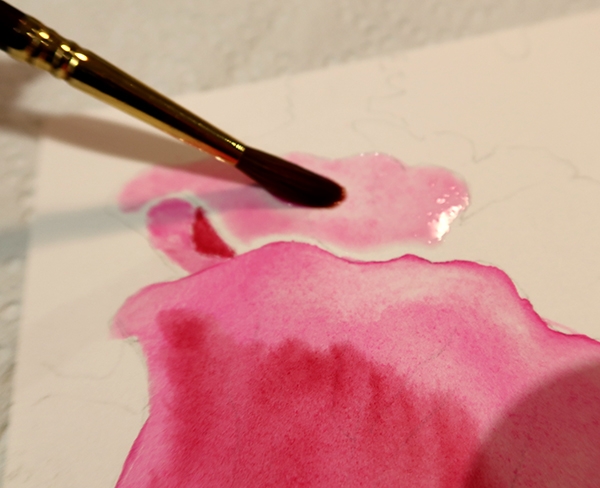
4. Theory. Charge the paint into the wet area. With a minimal amount of brush work, move it to the edges. Add any additional colors while the paint is still wet.
Practice. I used a No. 8 pointed brush, quickly flooding the area. I let gravity do much of the work, tilting the paper at a gentle angle to move the paint around and let it bead along the edge. I added the darker red, but made sure it was dryer than the wash on the page to avoid back runs.
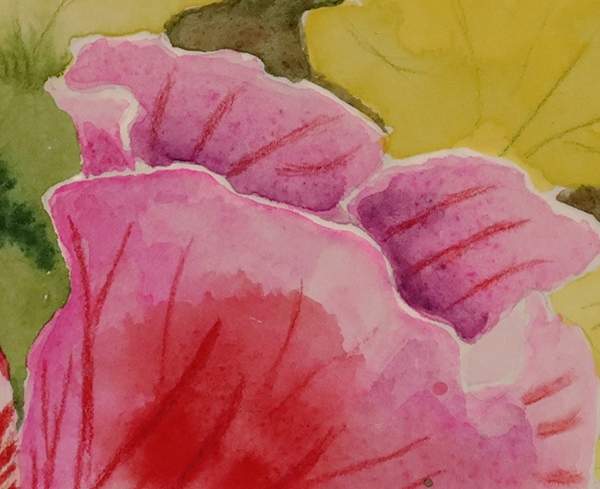
5. Theory. Let the paper dry thoroughly. Then use this same process to create the background. With clear water, paint as close to the edge of the petal as possible, about 1/8th to 1/16th of an inch. Charge in your background colors.
Practice. I did this twice. Once for the second petal and again for the leaves. For them, I used blends of Sap Green, Permanent Green, and Hansa Yellow Light.
Comment. Although I have presented this as a technique for rim lighting, you can use it just to achieve a hard edge on any object. Simply stop at Step 4.
If you have a steady hand, of course, you could paint a hard edge without the water. I use it for two reasons: 1) It guarantees my edge is precise. If I accidentally paint over the line, I can let the water dry and try it again. 2) It gives a consistently even wash.
If you try this, I would enjoy hearing how it worked for you and what innovations you add to it. Send me an image and an account of your experience, if you please.
Let’s make “My Favorite Technique” a regular feature of Brushstrokes. The next time there is a Call for Brushstrokes news, share some watercolor technique you like to use. Break down the process into steps and photograph each one. Cell phone photos will suffice for most everything; describe what you do in each step. Keep it short and simple: three to eight steps and photos. We all have something to share. Think of it as if you were at an in-person meeting and someone asked, “How did you do that?”
T.C. Steele Historic Site
Final 2020 paint-out in photos
Barbara Coffman, photographer

Member News
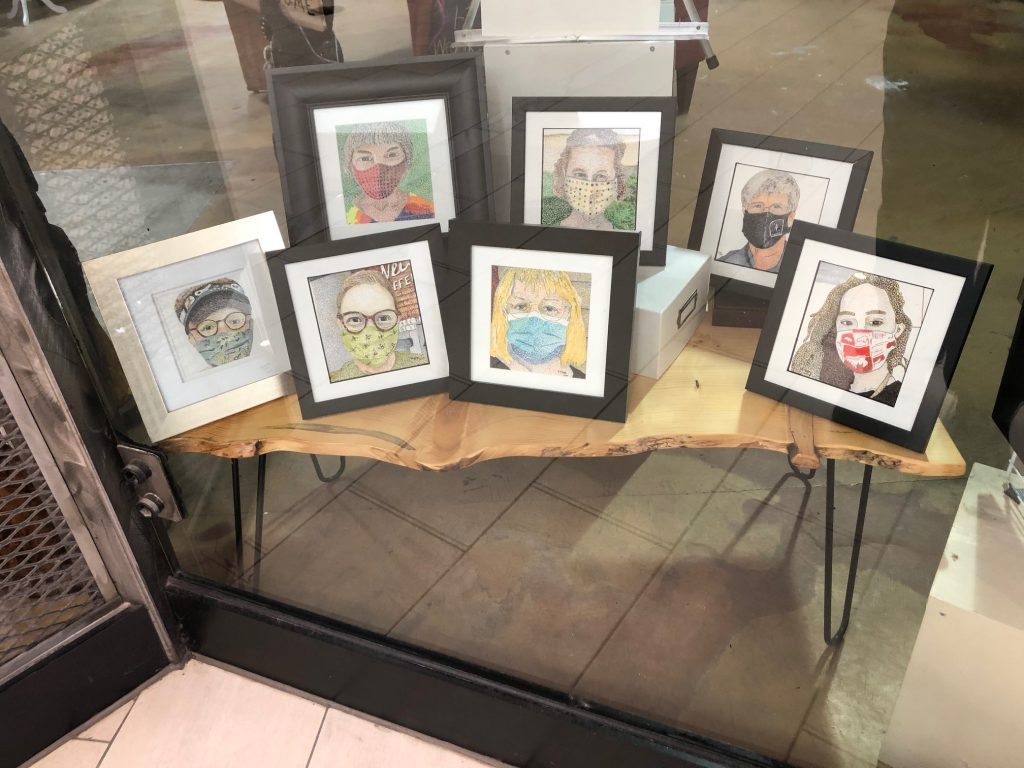
Susan Savastuk is displaying her series of Pointillism Covid-19 Mask portraits. They are done with marker on paper. You can view the display through the window at ArtBeat in the College Mall. The Bloomington Arts Alliance store is still closed.

Hopi Maidens, a watercolor painting by MarySue Veerkamp Schwab, is in the Richmond Art Museum Show Nov. 5 through Jan. 9. She says it is from a Hopi Ceremony she and her husband were invited to attend on First Mesa in Arizona.
Andy Roberts sent in three paintings he has been working on from plein air paint-outs and other outings in recent months. “Now that the nice weather is coming to an end,” he says, “I guess I will resolve to painting from the numerous photos I have taken at various locations around southern Indiana.” He still hopes to get back to Florida in January to paint his favorite subject matter: palm trees and seascapes.
Lynne Gilliatt sent in a portrait of Gallery mortgage owner John LaBella (left) and one she calls Spanish Soup (right), which incorporates black washi tape and gouache.
Calendar
Nov. 9 BWS Meeting via Zoom, Program by Kathy Barton
Nov. 18 Deadline for donating to the FMCCS Auction
Nov. 30 Bidding opens for FMCCS Auction
Dec. 9 BWS Holiday Celebration via Zoom, Artist Trading Cards
February Month of Chocolate

